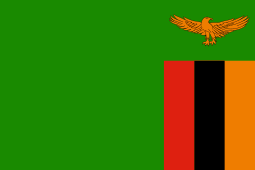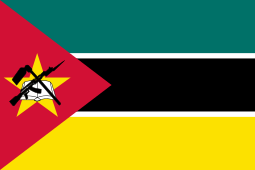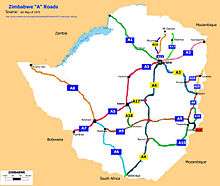Transport in Zimbabwe
The government of Zimbabwe is the main provider of air, rail and road services; historically, there has been little participation of private investors in transport infrastructure.[1]
Railways
The railway operator is National Railways of Zimbabwe.
Total: 3,427 km (2012).
Narrow gauge: 3,427 km at 1,067 mm (3 ft 6 in) gauge, 313 km of which is electrified (de-energized due to problematic power supply in 2008) (2002).
Note: this includes the 318 km Beitbridge Bulawayo Railway company line.
Railway links with adjacent countries




Stations served
Highways
There are 88,100 km of classified roads in Zimbabwe and 17,400 km of them are paved.[2][3]
Primary roads
This class is sometimes called "National Roads or Highways". About 5% of the road network are primary roads. Primary roads are the most trafficked and most link neighbouring countries. One such road is the Zimbabwean portion of the Trans-African Highway as it passes through western Zimbabwe. This part of the road network plays a major role in the importation and exportation of the country's ware and transit freight. Among the primary roads some roads are classified as Regional Road Corridors, while some are just primary roads.
Regional Road Corridors are numbered R1, R2, R3 and so on. They may also be called by their original type and route name like A1, A2, A3 etc. In some cases one type "R" road may be comprise two or more type "A" routes; e.g. R2 comprises A5 and A7 (Harare-Pluntree Road). Ordinary primary roads are numbered P1, P2, P3 etc. These are primary roads but not convenient for cross-border traffic and services.
Regional road corridors

• R1 = ( A4 ) (Harare-Masvingo-Beitbridge)
• R2 = ( A5 + A7 ) (Harare-Bulawayo-Plumtree)
• R3 = ( A1) (Harare-Chirundu)
• R4 = ( A2 (Harare-Nyamapanda)
• R5= (A3) (Harare-Mutare)
• R6 = (Chivhu-Nyazura)
• R7 = ( A17 ) (Gweru-Mvuma)
• R8 = (Rutenga-Sango)
• R9 = (A6 + A8 ) (Beitbridge-Bulawayo-Victoria Falls)
Source: [Map 9.2 Road Transport Network of Zimbabwe.][4]
Primary roads (ordinary)

• P1 = (Harare-Mt Darwin-Mukunbura)
• P2 = (Mt Darwin-Mukumbura) ? [Error on map]
• P3= (Marondera-Murehwa)
- P4= (Masvingo-Mutare)
- P5= (Ngundu-Tanganda)
• P6= = (Chivhu-Mutare)
• P7= (Mbalabala-Masvingo)
• P8= (Kwekwe-Nkayi)
• P9= (Nkayi-Lupane)
• P10= ( Lupane loop)
• P11= ( Kwekwe-Gokwe Highway )
• P12= ( Makuti-Kariba)
• P13=( Chegutu-Chinhoyi )
• P14= ( Victoria Falls-Kazingula)
(Source: [Map 9.2 Road Transport Network of Zimbabwe.])[5]
Secondary roads
Secondary roads make up 14% of the network in Zimbabwe. Secondary roads link the major centers within the country. These form a dependable network for the movement of both the people and goods. Some secondary roads are paved and some are gravel unlike primary roads which are all paved.
Trunk road system
The primary and secondary roads are collectively the trunk road system. The trunk road system carries 70% of the vehicular traffic. Traffic in question here is measured in vehicle kilometers. The trunk road system is managed by the Department of Roads.
Tertiary feeder and access roads
The roads that link rural areas to the secondary road network are called tertiary feeder and access road. These roads are managed by the District Development Fund (DDF) and by the Rural District Councils (RDC). These roads usually have traffic volumes less than 50 vehicles per day. Together with the unclassified roads and tracks they link rural communities to service centers, schools and health centers. These roads also provide government services to reach rural areas.
Urban roads
Urban roads make 9% of the road network. Urban roads are managed by urban councils and municipalities.
Road density in Zimbabwe
About 0.23 km per square kilometre is the road density in Zimbabwe. This is high compared with many developing countries. Only OECD countries have a substantially higher road density than Zimbabwe.[6]
Waterways
Waterways are not used for commercial transport; though some navigation is possible on Lake Kariba.
Pipelines
There is a pipeline for petroleum products 270 km long. (2013)
Ports and harbours
Binga, Chalala, and Kariba are on Lake Kariba.
Airports
196 (2013)
Airports - with paved runways
- total: 17
- Over 3,047 m: 3
- 2,438 to 3,047 m: 2
- 1,524 to 2,437 m: 5
- 914 to 1,523 m: 6 (2013)
Airports - with unpaved runways
- total: 179
- 1,524 to 2,437 m: 3
- 914 to 1,523 m: 104
- under 914 m: 72 (2013)
See also
References
- Mushonga, Master (5 October 2012). "Zimbabwe: Transportation Infrastructure Vital for Economic Competitiveness". AllAfrica.com. Financial Gazette. Archived from the original on 2013-08-21.
- African Development Bank |Chapter 9: Road Transport Services and Infrastructure-African|(Table 9.1).About 5 percent of the network is classified as primary roads and has some of the most trafficked arterials that link Zimbabwe with its neighbors. A portion of the Pan-Africa Highway passes through Zimbabwe (see Map 9.1). This part of the road network plays a major role in the movement of the country’s imports and exports as well as transit freight. Some 14 percent of the network is classified as secondary roads that link the main economic centers within the country, enabling internal movement of people and goods. The primary and secondary roads are collectively referred to as the trunk road system; they carry over 70 percent of the vehicular traffic (measured in vehicle kilometers) and they are managed by the DoR (DoR). A little more than 70 percent of the network is made up of tertiary feeder and access roads that link rural areas to the secondary road network. African Development Bank|Documents|Retrieved 25 March 2016
- Document of the World Bank |Africa Transport Sector (AFTTR)|Page 1 Report No. 43855-ZW|Roads Sector 3. Zimbabwe has a classified road network of about 88,300 kilometers (km), of which about 15,000 km is paved. The national paved road network has largely remained in fair or good condition but significant deterioration is occurring on urban and unpaved rural roads. About 24 percent of the entire road network was estimated to be in good condition in 2005. World Bank|Openlnowledge. Retrieved 27 March 2016
- African Development Bank Chapter 9: Road Transport Services and Infrastructure -African African Development Bank|Documents|Retrieved 25 March 2016
- African Development Bank Chapter 9: Road Transport Services and Infrastructure -African African Development Bank|Documents|Retrieved 24 2016
- African Development Bank |Chapter 9: Road Transport Services and Infrastructure-African|As Figure 9.1indicates, the road density in Zimbabwe is about 0.23 km per square km. This is high compared with many developing countries; it is comparable to that of the high income, non-OECD countries and lower middle-income countries. African Development Bank|Documents|Retrieved 25 March 2016